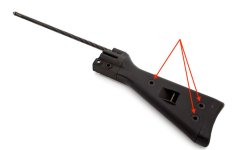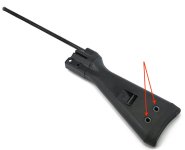yahamshari
New member
Hello.
I have wondered before why some HK G3 fixed buttstocks have three holes. Some say that they are early 1960s HK G3 plastic buttstocks. The three holes have the same internal diameter, which is too large to retain the forearm/trigger group pins. I heard a claim that those three-hole buttstocks date back to the early 1960s' Swedish Ak 4 rifles. They featured black color fiberglass similar to Colt's original AR-15/M16A1 buttstocks.
Q.1 What is the purpose of the third hole, is it just another retainer pin 'keeper' hole?
Q.2 I am considering getting a spare German (not Pakistani or PTR) two-hole complete fixed polymer buttstock (black) for my 1979 HK91 A-3. Do I need to consider 922(r) if one day I decide to replace at the range the collapsible stock of my pre-ban HK91 with an all-German fixed buttstock?
Q.3 If the answer to Q.2 is yes, then should I look for a fixed buttstock made of German and U.S. HK parts, which counts as one U.S. compliant part for 922(r)?
Q.4 Are all-German HK G3 fixed buttstocks (black) widely available in the U.S. or they're now scarce?
Q.5 Is is legal for me to bring a buttstock with me from Germany to the U.S. or mail it from there to the States?
This RFI is cross-listed on HKPRO, HK ProShop, Sturmgewehr, Carolina Firearms Forum, Carolina Shooters Club, and M14 Forum.
Thank you.
I have wondered before why some HK G3 fixed buttstocks have three holes. Some say that they are early 1960s HK G3 plastic buttstocks. The three holes have the same internal diameter, which is too large to retain the forearm/trigger group pins. I heard a claim that those three-hole buttstocks date back to the early 1960s' Swedish Ak 4 rifles. They featured black color fiberglass similar to Colt's original AR-15/M16A1 buttstocks.
Q.1 What is the purpose of the third hole, is it just another retainer pin 'keeper' hole?
Q.2 I am considering getting a spare German (not Pakistani or PTR) two-hole complete fixed polymer buttstock (black) for my 1979 HK91 A-3. Do I need to consider 922(r) if one day I decide to replace at the range the collapsible stock of my pre-ban HK91 with an all-German fixed buttstock?
Q.3 If the answer to Q.2 is yes, then should I look for a fixed buttstock made of German and U.S. HK parts, which counts as one U.S. compliant part for 922(r)?
Q.4 Are all-German HK G3 fixed buttstocks (black) widely available in the U.S. or they're now scarce?
Q.5 Is is legal for me to bring a buttstock with me from Germany to the U.S. or mail it from there to the States?
This RFI is cross-listed on HKPRO, HK ProShop, Sturmgewehr, Carolina Firearms Forum, Carolina Shooters Club, and M14 Forum.
Thank you.
Attachments
Last edited:


